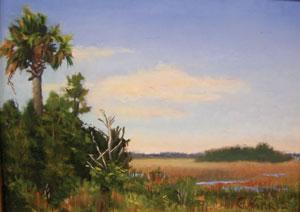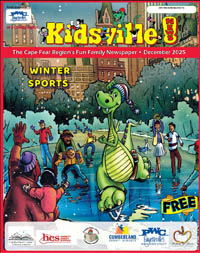Two exhibits in Fayetteville’s downtown galleries are a sharp contrast in
content, yet the influence of technology moves seamlessly among the works of art
in both galleries. Viewers will see everything from the computer-generated images
in the form of traditional Asian-style wall hangings to the many photographs in
the 2nd Annual College Faculty Invitational at Cape Fear Studios to the outdoor
landscape painters at Olde Towne Gallery, which also use photography as a tool.
A wonderful contrast of the traditional and new tool usage, both exhibits reminds us how we revisit approaches in art while moving forward. We still fi nd it fulfi lling to explore the traditional in a technology saturated culture by painting or drawing the landscape. A square ceramic teacup sitting on an inverted pyramidal saucer is still enticingly beautiful.
A large percentage of the faculty in the invitational exhibit probably do not know each other. In contrast, the four artists showing at the Olde Towne Gallery exhibit titled Road Trip, have painted together for years and are longstanding friends. The difference attributes to the overall aesthetics of each exhibition.
Nineteen faculty members from local and regional higher-education institutions are participating in the invitational: the University of North Carolina at Pembroke, Fayetteville Technical Community College, Methodist University, Fayetteville State University and Meredith College in Raleigh, N.C.
UNC-Pembroke was well represented in the Faculty Invitational. Design instructor Carla Rokes and printmaker Brandon Sanderson are exhibiting computer-generated graphic images ranging from the abstract to the fi gurative with a twist of dark humor. Dong Jun Shin demonstrates his expertise in ceramics. Margie and John Labadie have their lengthy computer-generated scrolls on the gallery walls. Ann Horton and Jo Ann Hart are exhibiting photographs of nature. Tulla Lightfoot has a landscape painting on display, while Janette Hopper has two mixed-media monoprints.
From Methodist University, Peggy Hinson is exhibiting one of her large mixed-media shadow boxes in a work titled The Sacrifi ce of the Lamb. Kerry Scott Jenkins is showcasing the art of typography; and Silvana Foti is sharing a new body of work — abstracts, which mix thin brass rods with computer graphics and water-based paint.
Painter Dwight Smith represents Fayetteville State University with his large, rhythmic, mixed-media collage. Jonathan Chestnut is exhibiting a single work in computer graphics. Shane Booth and Socorro Hernandez-Hinek are both exhibiting their new photographs.
One lone faculty member from Meredith College, Warner Hyde, a ceramist, returned to this year’s exhibition with one of his large organic forms, fl ower-like, but titled Fungal.
Fayetteville Technical Community College’s Sean McDaniel shares his fi gurative water-color studies, while the new member of the art department, Chuck Lawson, participates with a two-dimensional design titled Dance, Dance, Dance.
The variety of works in the exhibition exemplifi es the infl uence of technology in this group of artists — the use of the camera and the computer. Prevailing themes include religion, abstraction and design.
Unlike the artists in the Faculty Invitational, the four artists participating in Road Trip exemplify how similar can have many variations. Road Trip includes the works of Sandie McFarland, Rose Kennedy, Gail Harris and Annette Sczczkutek. The exhibit is the result of participating in a long weekend workshop in “plein air” landscape painting with landscape artist William Jameson.
Road Trip is an enjoyable exhibit and is the result of an interesting circumstance. The “plein air” painter Jameson was featured in American Artist Workshop magazine and called Harris and Szczekutek to participate in a long weekend workshop that would be documented, then appear in the publication. The four friends decided to participate together as a group.
Working in different mediums, the four artists worked side-by-side each day, while Jameson regularly visited them to review their progress and give constructive instruction. Szczekutek worked in oil paint, while Harris, Kennedy and McFarlane used oil, pastels or watercolors.
I asked McFarlane if she could highlight what she learned with Jameson about working outside and directly from nature. McFarlane was quick to remark: “We worked on site, had one-on-one demonstrations by the instructor. He talked a lot about value and artistic license in a work of art. I learned a great deal about using a limited palette — a view fi nder — so I am not distracted by all the details in nature around us. This allows me to do a sketch quickly to capture the values in a situation where light changes and to use negative shapes as a reference source.”
While you visit Road Trip, look carefully on the information table in the gallery and you will see a copy of American Artist Workshop. Six pages are fi lled with how-to-do text, Jameson’s palette choices, his “12 things to remember about outdoor landscape painting,” and many pictures of Jameson working with the four local artists.
All of the works in the gallery are examples of what Jameson wanted his students to remember about outdoor landscape painting. They all used a “limited palette, worked from big shapes to little shapes, dark values to light values, cool colors to warm colors.” Each artist identifi ed in their work a “center of interest, established a horizon, observed atmospheric perspective, and positioned themselves with the sun on their left or right side.”
The workshop took place in South Carolina’s low county islands of Seabrook, Kiawah and Wadmalaw. The light in each painting becomes more signifi cant than the subject. Each artist worked to capture light that happens when dense foliage opens up to a small pond, an open sky or a watery vista. The wash of light across the surface of a building is more important than the type of building.
With the changing light, each artist needed to take a photograph of the place and the time of day so they could complete the painting or drawing later, after the light had changed so drastically from when they started on the work. Many of the artists fi nished up to five or six pieces.
Anyone interested in undertaking a “plein air” approach to painting will have the opportunity to attend a local workshop by Diane Johnson (founding editor of Plein Air Magazine). The workshop is hosted by Cape Fear Studios and will take place on April 23-25. For information on the workshop, visit the Cape Fear Studios Web site at www.capefearstudios.com or call the studio at 433-2986.
The 2nd Annual College Faculty Invitational is an annual
event and will remain open until the third week of February.
Road Trip will remain open until Feb. 24. Both exhibits are free
and open to the public Monday through Saturday.

 How to resolve AdBlock issue?
How to resolve AdBlock issue? 








